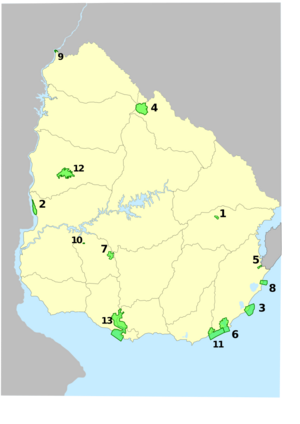National System of Protected Areas in Uruguay facts for kids
The National System of Protected Natural Areas of Uruguay (in Spanish: Sistema nacional de áreas naturales protegidas de Uruguay), often called SNAP, is a special program in Uruguay. Its main goal is to protect and manage the country's natural spaces.
SNAP was created by a law passed on February 22, 2000. This law helps make sure that all protected areas in Uruguay are managed in a similar way. It sets clear rules and guidelines for how these important natural places should be cared for.
What are the Main Types of Protected Areas?
Uruguay's law (Law 17234) set up four main types, or categories, for its protected natural areas. Each type has a different purpose and way of being managed:
- National Park: These are large areas where nature is mostly untouched by people. They have special plants, animals, and beautiful landscapes. These parks are important for science, education, and for people to enjoy nature.
- Natural Monument: These areas protect one or more very special natural features. This could be a unique rock formation, a rare plant, or an animal's home that is in danger. Human activity here is very limited and carefully watched.
- Protected Landscape: These are areas where the beauty of nature and human activity have mixed over time. They are protected because they offer a special view or a unique way of life that depends on the land.
- Protection Site: These areas are protected for specific reasons, often to preserve a certain habitat or a particular species.
List of Uruguay's Protected Areas
Uruguay has 22 protected areas that are part of SNAP. Together, these areas cover about 3.68% of the country's land.
National Protected Areas
These areas are recognized and protected by Uruguay's own laws.
National Parks
- Cabo Polonio National Park
- Esteros de Farrapos e Islas del Río Uruguay National Park
- Isla de Flores National Park
- San Miguel National Park
Natural Monuments
Protected Landscapes
- Laguna de Castillos
- Laguna de Rocha
- Localidad Rupestre de Chamangá
- Paso Centurión y Sierra de Ríos
- Quebrada de los Cuervos y Sierras del Yerbal
- Valle de Lunarejo
Protected Areas with Managed Resources
These areas allow some human activities, but they are carefully managed to protect natural resources.
- Humedales del Santa Lucía
- Montes del Queguay
Habitat and Species Management Areas
These places are specifically managed to protect certain animal habitats or plant species.
- Cerro Verde
- Esteros y Algarrobales del Río Uruguay
- Laguna Garzón
- Rincón de Franquía
International Protected Areas
Some of Uruguay's protected areas are also recognized by international organizations.
UNESCO-MAB Biosphere Reserves
These areas are part of a global network that aims to balance conservation with sustainable human development.
- Bañados del Este y Franja Costera
- Bioma Pampa Biosphere Reserve
Ramsar Sites
These are wetlands that are important for waterbirds and biodiversity worldwide.
- Bañados del Este
- Esteros de Farrapos e Islas del Río Uruguay National Park
- Laguna de Rocha
See also
 In Spanish: Sistema Nacional de Áreas Protegidas (Uruguay) para niños
In Spanish: Sistema Nacional de Áreas Protegidas (Uruguay) para niños


